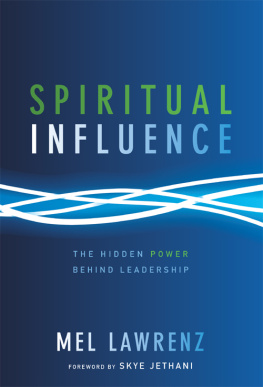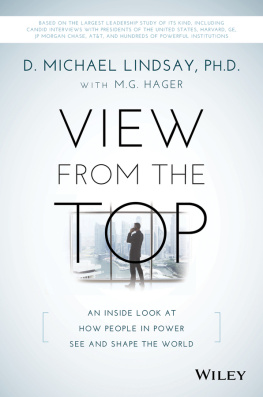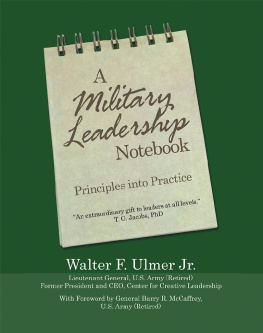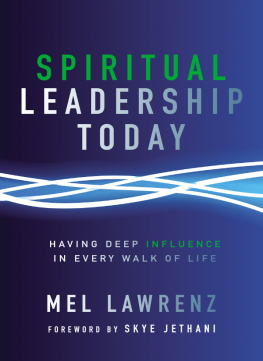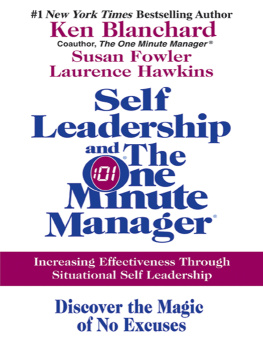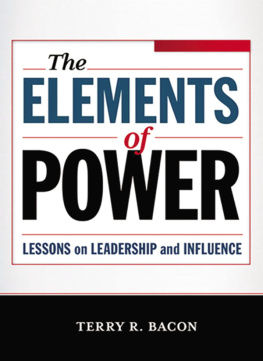The
ELEMENTS
of
POWER
The
ELEMENTS
of
POWER
ALSO BY TERRY R. BACON
Selling to Major Accounts:
Tools, Techniques, and Practical Solutions for the Sales Manager (1999)
Winning Behavior:
What the Smartest, Most Successful Companies Do Differently
(2003, with David G. Pugh)
The Behavioral Advantage:
What the Smartest, Most Successful Companies Do Differently
to Win in the B2B Arena
(2004, with David G. Pugh)
Powerful Proposals:
How to Give Your Business the Winning Edge
(2005, with David G. Pugh)

Readers can find more information on these books, as well as The Elements of Power and other current topics in talent management and human performance, at www.terryrbacon.com. Additional information on the research behind The Elements of Power, including power-and-influence profiles of forty-five countries, is also available at www.kornferryinstitute.com or www.theelementsofpower.com.
The
ELEMENTS
of
POWER
LESSONS on LEADERSHIP and INFLUENCE
TERRY R. BACON

Bulk discounts available. For details visit:
www.amacombooks.org/go/specialsales
Or contact special sales:
Phone: 800-250-5308
E-mail: specialsls@amanet.org
View all the AMACOM titles at: www.amacombooks.org
This publication is designed to provide accurate and authoritative information in regard to the subject matter covered. It is sold with the understanding that the publisher is not engaged in rendering legal, accounting, or other professional service. If legal advice or other expert assistance is required, the services of a competent professional person should be sought.
Disclaimer: The opinions expressed here are the views of the writer and do not necessarily reflect the views and opinions of Korn/Ferry International.
Library of Congress Cataloging-in-Publication Data
Bacon, Terry R.
The elements of power : lessons on leadership and influence / Terry R. Bacon.
p. cm.
Includes index.
ISBN-13: 978-0-8144-1511-5 (hardcover)
ISBN-10: 0-8144-1511-3 (hardcover)
1. Leadership. 2. Control (Psychology) 3. Interpersonal
communication. I. Title.
HD57.7.B323 2011
658.4092dc22
2010027654
2011 Terry R. Bacon
All rights reserved.
Printed in the United States of America.
This publication may not be reproduced, stored in a retrieval system, or transmitted in whole or in part, in any form or by any means, electronic, mechanical, photocopying, recording, or otherwise, without the prior written permission of AMACOM, a division of American Management Association, 1601 Broadway, New York, NY 10019.
About AMA
American Management Association (www.amanet.org) is a world leader in talent development, advancing the skills of individuals to drive business success. Our mission is to support the goals of individuals and organizations through a complete range of products and services, including classroom and virtual seminars, webcasts, webinars, podcasts, conferences, corporate and government solutions, business books, and research. AMAs approach to improving performance combines experiential learninglearning through doingwith opportunities for ongoing professional growth at every step of ones career journey.
Printing number
10 9 8 7 6 5 4 3 2 1
PERMISSIONS AND CREDITS
Introduction: Katharine Graham (Photo by Arnold Newman/Getty Images); Jim and Tammy Faye Bakker (Photo by Scott Miliman/AFP/Getty Images).
.
: Bill Gates (Photo by Chuck Nacke/Getty Images); Maya Angelou (Photo by Frederick M. Brown/Getty Images); Martin Fleischmann and B. Stanley Pons (Photo by Diana Walker/Time Life Pictures/Getty Images).
: Dr. Martin Luther King (Photo by Rolls Press/Popperfoto/Getty Images); President George W. Bush (Photo by Brendan Hoffman/Getty Images).
: Arsenal fans at Waterloo Station (Photo by S. R. Gaiger/Topical Press/Getty Images); Robert Young as Dr. Marcus Welby (Photo by ABC Television/Courtesy of Getty Images); Xu Jinglei (Photo by Carlos Alvarez/Getty Images); Quotation from the film Taxi Driver courtesy of Columbia Pictures. Used with permission.
: Brad Pitt and Angelina Jolie (Photo by Robyn Beck/AFP/Getty Images); Ann Coulter (Photo by Rob Hill/FilmMagic).
: Eleanor Roosevelt (Photo by Joseph Scherschel/Time Life Pictures/Getty Images); Eliot Spitzer (Photo by Timothy A. Clary/AFP/Getty Images).
.
: Quotations from the film Network courtesy of MGM Studios. Used with permission. Indra Nooyi (Photo by Brian Ach/WireImage); Ali al-Naimi (Photo by Hassan Ammar/AFP/Getty Images).
: Quotations from the film Serenity courtesy of Universal Pictures. Used with permission. Dr. Peter Pronovost (Johns Hopkins University School of Medicine. Used with permission); Fareed Zakaria (Photo by Joe Kohen/WireImage).
: Rahm Emanuel (Photo by Justin Sullivan/Getty Images); Vice President Dick Cheney with President George W. Bush (Photo by Alex Wong/Getty Images); Cartoon of Dick Cheney (Mike Peters EDTCTN (New) King Features Syndicate).
: Aung San Suu Kyi (Photo by Pornchai Kittiwongsakul/AFP/Getty Images); Warren Buffett (Photo by Nicholas Roberts/AFP/Getty Images).
: Mark Zuckerberg (Photo by Suzanne Plunkett/Bloomberg via Getty Images); Jeff Bezos (Photo by Toru Yamanaka/AFP by Getty Images).
.
: Sister Mary Scullion (Photo by Jeff Fusco/Getty Images); Jeremy Gilley (Photo by Astrid Stawiarz/Getty Images).
CONTENTS
PREFACE
TWENTY-FIVE YEARS AGO, BRITISH POP DUO TEARS FOR FEARS RELEASED their hit song Everybody Wants to Rule the World. I remembered that song five years later when a senior human resources manager at a division of General Electric asked me to develop an educational program on influence effectiveness. She felt that many of the employees she was responsible for were not skilled at influencing upward or laterally within their matrix organization and were not nearly as persuasive as they needed to be with customers. Many of them dont have strong enough presence, she said, and they arent good at getting their ideas across. They cant read audiences and dont know how to adapt to them. All they do is tell customers about the features of our products and services. Too many of our recent hires are going to fail if we dont teach them how to use power and influence.
To meet her need, I spent several months in university libraries searching for and reading everything I could on the topic of power and influence in organizations. Although the research was often enlightening, none of it offered what I felt was a comprehensive picture of how people develop the power necessary to influence others effectively. I sought a model of power and influence that could describe every instance of influencefrom street beggars to dictators, from friends doing favors for one another to colleagues working together on teams, from athletic coaches to executive coaches, and from mail room clerks to CEOs. As a business consultant, I was primarily interested in how power and influence were used in the world of work, but I quickly realized that there were numerous parallels with how power works in politics and government, the military, the church, the media, social organizations, and families. In fact, the exercise of power in politics and nonbusiness organizations is essentially indistinguishable from the exercise of power in companies, so businesspeople can learn much about power from how it is used in other domains.
Next page


